What Increases The Risk Of A Vitamin K Deficiency?
Vitamin K is not one specific vitamin, rather it is a category of compounds responsible for aiding in blood clotting, regulating calcium in the blood, and bone metabolism. Vitamin K1 is typically found leafy green vegetables while vitamin K2 is found meats, eggs, and cheeses. When an individual is vitamin K deficient, they lack the proteins necessary for the blood to clot. This can be a dangerous condition as it can lead to excessive bleeding. Vitamin K deficiency is more common in infants than adults, but certain medications and conditions can cause a deficiency in adults.
Low Dietary Intake

Low dietary intake is one of the primary causes of vitamin K deficiency in infants and children. This is due to the fact breast milk is very low in vitamin K. Adults can become deficient in vitamin K if they do not consume enough of the foods that contain the compound. The recommended daily intake of vitamin K for adult males is 120 micrograms and ninety micrograms per day for adult females, but most adults in the United States are only consuming eighty to eighty-five micrograms per day on average.
Deficiency due to low dietary intake can be avoided by being consuming the recommended daily intake of vegetables, especially dark, green, leafy vegetables, which are packed with vitamin K. Another vegetable rich in vitamin K is broccoli, where a one cup serving has more than 160 micrograms of vitamin K.
Fat Malabsorption

Individuals with fat malabsorption, a condition that makes it difficult to absorb fat, are at increased risk for developing a vitamin K deficiency. This is due to the fact vitamin K is fat soluble, meaning it must be combined with fat in order to be properly absorbed in the body. Fat malabsorption is commonly associated with celiac disease, cystic fibrosis, disorders of the liver, gallbladder, and bile ducts, and patients who have had portions of their intestine removed. If a vitamin K deficiency is caused by the body's inability to absorb individuals may experience frequent nosebleeds, heavy menstrual bleeding, and gum bleeding.
